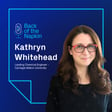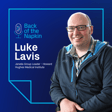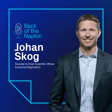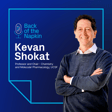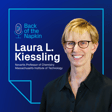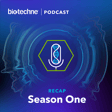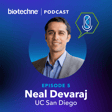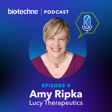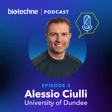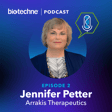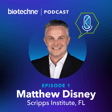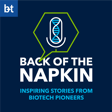How Do Discoveries Happen?
00:00:03
Speaker
A discovery is said to be an accident meeting a prepared mind, but every story behind a discovery is different.
00:00:11
Speaker
Perhaps the idea is conceived in a light-bulb moment, or a brainstorming session, or captured in scribblings on the back of a napkin. Here, we introduce you to scientific pioneers, taking you beyond their publication, and into Innovation Corner to hear the untold stories behind their discoveries.
Who is Michelle Arkin?
00:00:30
Speaker
This podcast is brought to you by Biotech, and I'm your host, Alex Maloney.
00:00:37
Speaker
Our guest today is Michelle Arkin, Professor of Pharmaceutical Chemistry at the University of California, San Francisco. Michelle is also the Director of the Small Molecule Discovery Center at the University, which at the time Michelle joined was one of the first examples in her academic facility that was professionalizing drug discovery.
00:01:00
Speaker
Michelle has an enormous amount of experience in this field and now continues to apply methods that she's helped to pioneer to demonstrate drugability of new target classes.
00:01:12
Speaker
Further, Michelle has an entrepreneurial string to her bow and has co-founded multiple companies, one of which is Ambergone Therapeutic, and we spent some time talking about the exciting ideas and concepts that started this company. Michelle is also an incredibly personable and empowering leader who is inspiring the next generation of drug hunters.
00:01:34
Speaker
These are exciting times for drug discovery, and as you'll hear in this episode, the convergence and intersectionality of new approaches to drug development have opened up vast possibilities. While we're already witnessing the realisation of some of these breakthroughs, we're merely scratching the surface of what lies ahead.
What Inspired Michelle's Career in Chemistry?
00:01:54
Speaker
Welcome to back of the napkin.
00:02:01
Speaker
Michelle, hi. Welcome to back of the napkin. It's great to have you here. Well, it's great to see you again. Thanks for inviting me. So we first crossed paths this year actually earlier at a conference in San Diego where you were giving the plenary talk and I was looking back at my notes and right at the top of the page I've got invite Michelle onto back of the napkin with four exclamation marks on it. It's great.
00:02:28
Speaker
Thank you. Well, you know, I don't know you well enough to know if four is a lot. Is four a lot? Was a lot, yeah. Well, that's good. Good. Yeah, because my daughter, like, four is good morning. Yeah, four is, that's a high bar for me, four, so. Okay, well, thank you. I appreciate that. I really feel honored. So let's build some foundations here then, Michelle. Talk me through how you got into science and take me back as far as we need to go here.
00:02:58
Speaker
Well, my father's a doctor and I liked science in school. So I guess I thought I might go into medicine. So I was pre-med, which means I took the chemistry classes when I went to university at Bryn Mawr in the US. And in my first class, so my first chemistry class, big class, like 120 people was a big class at liberal arts college. And my professor called me down to the bottom
00:03:27
Speaker
you know, the lectern at the bottom of the amphitheater after class. And she said, oh, I just want to meet you because, you know, people who are doing well in class, you know, sometimes you don't meet them. And I just wanted to say hi. And then after the third test, she had another note at the top that said, please come see me. And I walked down here and she said, what happened? You bombed that test.
00:03:50
Speaker
So I think that was really, you know, that made a big impression that this big classroom that somebody would notice you would see you and see how you're doing. And that was not my experience in public high school. So I really appreciated that. And it and it drew me more into science that the
00:04:06
Speaker
student, my teachers even when I was a freshman, took some interest, my physics teacher did too. And at the same time, I was taking art history and I really fell in love with art history and being able to look at pictures in a dark room and think about how art was made. And I had done a lot of theater in high school, so I had kind of already bent and
00:04:31
Speaker
I started learning about our conservation science. So this is the science of how an artwork is made, how it changes through time, how if you want to restore it or improve it, how you might go about it that's in alignment with what the artist had intended. And this really stimulated me.
00:04:49
Speaker
It was a double major for a while in chemistry and art history and worked at the Smithsonian. And so that was a thread that I found really exciting was linking this art and science.
00:05:02
Speaker
Then when I graduated, I decided to go into chemistry rather than art conservation science. I think honestly I was just intimidated by how few positions there were in art conservation science. It was really a new thing and I talked to a scientist and he discouraged me.
00:05:20
Speaker
Now, if I could go back and tell that person, you know, my 21-year-old self, I'd say, you know, why can't you be the 11th person who has this job?
What Was Michelle's Pioneering Work at Caltech?
00:05:30
Speaker
Why let this person intimidate you instead of see what you have to offer? And so, I allowed myself to be intimidated. But it worked out. So, I went to graduate school in chemistry at Caltech and did some really interesting work and kind of set me on my path
00:05:47
Speaker
You're doing your PhD at Caltech then, and what's that? And so you've majored in chemistry, and what have you decided to kind of specialize on then for your PhD? I see first-year graduate students all the time now.
00:06:02
Speaker
at the university where I work and some of them get really worried about what labs to join and I try to say it's okay, it won't be that, it's not that. Earth shattering or life shattering a decision but actually I took it very hard and very seriously and at Caltech in chemistry
00:06:21
Speaker
the time, we didn't have rotations. You started school and you chose a lab and you were in a lab within a couple of months. And so, that was kind of scary. And so, I saw it a lot, a lot, a lot about it and ended up working for Jackie Barton in
00:06:40
Speaker
on this project that was new to her lab, and it was, again, it was this combination of a lot of different ideas, and it was really kind of a wild idea, and that was appealing to me. It was scary, but I thought that I had some of the skill sets that were necessary in spectroscopy and inorganic chemistry to help make her project work. And so I started on this project called DNA Mediated Electron Transfer, which sounds very arcane.
00:07:10
Speaker
But the idea of it is this revolutionary idea that the way DNA is held together, we think of it as being hydrogen bonds that hold the base pairs together, but actually what holds the helix together energetically is the electronic interaction between bases. So this polarizability between the bases that make them say a soft glue and then they are tacky and they bind to each other.
00:07:37
Speaker
And that electronic interaction also allows them to move electrons back and forth. This was the idea. And she had some very preliminary data, and she's this very creative, very big thinker, and she extrapolated this idea, and then we developed better tools, better and better tools over the period of my PhD to actually evaluate this phenomenon, study whether it was true or what its properties were.
00:08:03
Speaker
And now it's, her lab's been working on it ever since. So it was really, it was a risk that was well taken, I think.
00:08:12
Speaker
Yeah, it sounds like an exciting project and something that was great to be there at the beginning of this. And then you move on to do a postdoc after your PhD,
Why Did Michelle Transition to Genentech?
00:08:23
Speaker
right? And this was at Genentech. So that's quite a gem right going from academia and then going through a postdoc in industry. So what kind of catalyzed this transfer?
00:08:37
Speaker
Yeah, this was, I'd say 60% personal and 40% scientific. So yes, it was an exciting project at the time, the DNA project, but it was also really controversial. And the controversy surrounding it had a personal quality to it, a personal attack quality that just was not worth it to me personally to continue to be part of. And so I really wanted to just change disciplines altogether.
00:09:06
Speaker
So I figured I would be a biochemistry professor and I had experience in inorganic chemistry and nucleic acids chemistry and nothing in protein chemistry and a lot of the game is in proteins. So I asked my friends at Caltech who worked in protein science, what's the coolest thing happening?
00:09:25
Speaker
And who's the best person doing it? Who's a person that I would really want to work with, want to have as a mentor? And they all to a person said Jim Wells. Oh, okay. I don't know. You're looking at me like that. Maybe that's a little lazy. Like I could have read the literature instead of asking my friends, but it only occurs to me now. But they were actually they that crowdsourcing was really was good. And it's true. It was really exciting work.
00:09:55
Speaker
And at the time, Genentech was doing things that labs couldn't do, academic labs couldn't do. If you think about the kind of big science that we can do in academics now, at the time, any kind of automation, even DNA sequencing,
00:10:14
Speaker
expressing lots of different proteins and what Jim was working on called phage display. Site-directed mutagenesis was still like a technique that you learned. It wasn't something that just happened and developing that into these really high
00:10:30
Speaker
display technologies like ph display was a really exciting new approach to tackle protein science. And that appealed to me, the idea of doing something completely different in a really different environment. And Genentech was very sciency. Even though it was a large company, it was still
00:10:56
Speaker
innovation driven and had that fun starting the kind of mentality, at least in protein engineering department that Jim was in. So I was fortunate to get that postdoc and worked with really amazing people and changed the direction of my career entirely.
What Challenges Did Michelle Face at Sinesis?
00:11:15
Speaker
Yeah, I did my PhD in protein engineering. So whenever I hear about kind of protein engineering, phage display, and all these different direct evolution approaches, yeah, I love that. Yeah, it's amazing. And still today, the techniques have been around for a long time, but there's
00:11:35
Speaker
so much innovation that can still be done. These technologies, they're not one and done, they're continually evolving. I was only there for a year and a third, a little over a year, but I learned a lot, made so many connections, really was my first introduction to biotech. I don't know, when you started at the company, what year first? Like, oh, I'm not in academics anymore. My first moment,
00:12:04
Speaker
was that I didn't need to put a code into the Xerox machine, the copy machine. We all have the same speed type. We all have the same funding source.
00:12:22
Speaker
So it seems like you made a great connection with Jim Wells then at Genentech on this project. So tell me about what happened next because this seems to be like a pretty key transition as well moving away from Genentech.
00:12:40
Speaker
It does. It's another fork in the road, I suppose. And the opportunity there was after 18 years, Jim was leaving Genentech to start his own company. And this is in the first dot com boom. So we are in Silicon Valley in the dot com boom. Everybody's starting companies. There's tremendous energy around that. And he had an idea with a colleague from
00:13:10
Speaker
from Berkeley to tackle these undruggable targets. What we today even still call undruggable targets are hard to drug targets or high-hanging fruit to drug protein-protein interactions. This is what he had been working on at Genentech.
00:13:31
Speaker
felt he had a good understanding of how proteins interacted with each other and how you could turn that knowledge into making small molecules, oral drug-sized molecules, that could do the same thing, that could block these protein-protein interactions. And a big paper came out from Steve Fasek and Phil Haduck's labs at Abbott, now AbbVie, on what was called fragment-based drug discovery.
00:14:00
Speaker
SAR by NMR exactly this landmark paper and John and Jim had other ideas about how to do fragment based drug discovery but to apply it to protein-protein interactions and this crazy idea new target class new technology Startup funds were available for that kind of idea in the late 90s and so
00:14:27
Speaker
he was leaving to do that. And the opportunity, there were four postdocs in his lab. He always had four postdocs, and two of us decided to stay at Genentech and now have fantastic academic careers, and Deb Sedue and Greg Weiss. And two of us, Dan Erlinson and I, decided to go to the company to help him start it.
00:14:49
Speaker
And I don't know what Dan's rationale was. My rationale was, when am I going to have this opportunity again? And so jumped into the great unknown. And it was really fun. How important everything was. Everything that happens is a chunk, a big fraction of what's happening at the company. And I found that very motivating, stimulating.
00:15:17
Speaker
very intellectual energy and problem solving and taking responsibility for what was happening. That energy I really enjoyed and got a lot out of. And what was your role then from kind of day one? What were you coming in to do?
00:15:35
Speaker
So startup companies don't always hire the person who's best for what needs to be done. Sometimes it's who's least inappropriate for what needs to be done. So I had done laser spectroscopy in graduate school. So I did NMR spectroscopy at Cinesis because, you know, spectroscopy, even though it's all very different, but it, um,
00:16:04
Speaker
I was one of the biochemists. So in the HIIT finding, how would we find molecules? How would we validate that they're real? How would we advance them working with the chemists and then eventually with cell biologists to push molecules forward? So I was at the early stage of the drug discovery pipeline. I mean, we all were. That was all that was known was this idea how to find the molecules. And
00:16:29
Speaker
in really thinking through what's the best way to find fragments and link or optimize fragments to bind to these challenging surfaces at the interface of protein-protein interactions. You know, the idea why people think these are undrugable, and I talked about it in that plenary talk you mentioned, these two
00:16:53
Speaker
opposite ideas make protein-protein interactions challenging. One is they can be intrinsically disordered proteins until they bind, so there's no binding site because the protein's disordered, or they're big as the spaghetti, or they're big, flat surfaces. That's the cliff face with the rock climber hanging onto the cliff face.
00:17:17
Speaker
And I don't think either of these is exactly true. Let's call them edge cases to the spectrum of what's really happening there.
00:17:26
Speaker
But that's where we were. We thought these are probably big flat surfaces. If we find little fragments to bind into these little subsites at this surface and we link them together, we can make a molecule that would be too complicated to design from scratch, but could bind to the functionally important parts of these large protein-protein interfaces.
00:17:52
Speaker
And there's a lot of biochemistry and biochemical hypotheses behind that, which we can go into if you want to talk about it. But operationally, the challenge is
00:18:07
Speaker
Because these molecules are small and we're using high concentrations of the molecules because they're small, they don't have a high binding energy. So we use a high concentration to populate the bound state. And these proteins are challenging proteins. There are a lot of artifacts that come up.
00:18:25
Speaker
And we quickly realized that and turned to developing a number of approaches to validate that the compounds are binding to the sites that we think they are, that they're interacting with the proteins in the way for the reasons we think they are.
00:18:41
Speaker
And so we developed a number of biophysical tools that are also pretty commonly used now, very commonly used now in drug discovery, but they weren't that commonly used back then, like surface plasma and resin and NMR, crystallography was commonly used, but different methods to demonstrate mechanism of action, mechanism of binding.
00:19:00
Speaker
So that was a big learning that has impacted a lot of how we think about drug discovery and I think how we can be effective doing chemical biology. And you found some fantastic molecules that made it all the way through to being approved, right? So tell me about these.
00:19:23
Speaker
Oh, you know, new drug discovery is never a linear story. So there are two stories that I'll tell you about. One did not make it to a drug, we stopped working on it pretty early in the development phase. But that was a scientifically important discovery.
00:19:44
Speaker
where we were looking at the protein interleukin 2. Okay, here's the other thing. Because we were early in the game with protein-protein interactions, the idea was let's reduce risk about the target itself by taking targets that had antibodies that were on the market. So we know that they're therapeutically important. If we can do better than the antibody in some way, then we de-risk the biology.
00:20:12
Speaker
But looking back, knowing more now about these kinds of systems, we also picked some of the most difficult targets because those extracellular proteins, as opposed to intracellular proteins, extracellular protein-protein interactions are more of those
00:20:29
Speaker
big Cliffs coming together those rigid large rigid surfaces coming together. The proteins are disulfide bonded to themselves So they're more structurally rigid the protein protein interactions can be higher affinity. This is a different It's a challenging game So interleukin 2 was in that class there was an antibody on the market for inflammation for immunity so we
00:20:59
Speaker
There was also a compound that had just come out in Jack's communication from Tilly and other slabs at Roche.
00:21:09
Speaker
This molecule they designed it mimicking IL-2 and they wanted it to bind to the receptor But in fact it bound to IL-2 itself. So it was like a fantastic failure. It was like a super successful failure and This molecule and they had done some NMR with it. We then crystallized it and in
00:21:33
Speaker
that gave us a bunch of ideas for how to make better molecules, how to make our own molecules that mimic some of these interactions, but others would be new and better, more drug-like. And so for these molecules, we took up this fragment-like approach, and we ended up with a molecule that had essentially three fragments linked together, or three pharmacophores linked together. So it's a big linear molecule that covered the surface of the
00:22:03
Speaker
protein-protein interaction interface. The problem with that molecule is that the antibody really wasn't making any money.
00:22:13
Speaker
So it was de-risked, but also to be honest with you, we weren't very strong in biology there. We had a few really good biologists, but we didn't say, okay, we have this cool molecule, how can we use it? We said, well, this is not that important of a target. We'll publish it as a demonstration, and I think it has been a valuable demonstration project for people thinking about protein-protein interactions, but it wasn't. We weren't going to pursue it for drug discovery.
00:22:42
Speaker
And then I hopped on a project and ran the cell biology parts of the project for LSA1 ICAM. This is another immunology project. And in this long circuitous story, we started off doing allosteric inhibitors and fragment-based drug discovery. And there was another project team working in parallel, starting from
00:23:07
Speaker
essentially a literature bust. So Genentech had published a peptidomimetic inhibitor of LFA-1 in Science Magazine. And the person who published that had since become our VP of chemistry at Cinesis.
00:23:28
Speaker
Bob McDowell, and he suggested, well, let's work on this also. Let's try to make this more drug-like and orally bioavailable. So we stopped working on the fragment project, and I started working with that group on this peptidomimetic project and developing the cell-based acids to evaluate those compounds. And those were the primary screens were cell-based.
00:23:54
Speaker
We developed these molecules in the end, made some really nice molecules, but they weren't orally bioavailable because they had an acid on them that made it difficult. And aliphatic acid made it difficult to get them cell permeable and we stopped working on it. So then sat on the shelf.
00:24:14
Speaker
and some colleagues of Bob's from Genentech had then left Genentech, started a company called Sarcode, and they had an idea for how they would use this non-cell permeable LFA-1 inhibitor. They would use it in the eye for inflammatory conditions in the eye.
00:24:33
Speaker
because that there you don't want systemic exposure. You want it to just stay in the eye. So the properties that made this molecule terrible for what we wanted made it good for what they wanted. So we licensed the molecule to them.
00:24:49
Speaker
They developed it into a drug, which laphidograss for inflammatory dry eye, which is actually a really big market. And the only drug that was on the market for it was cyclosporine. Well, I draw cyclosporine. Around that time, Sarcode got bought by a company that then got bought by Shire, and now the drug is marketed by Novartis.
00:25:19
Speaker
That's exciting. So you were there. You've got the origin story then. And it's nice to kind of see how these things can be repurposed and reworked.
00:25:33
Speaker
I think the other thing about it, Alex, is that it takes a champion to really make a drug, to turn a molecule into a drug.
How Did Michelle Return to Academia?
00:25:43
Speaker
It takes people, these people had been at multiple companies and coming back to the same idea. It's like this idea was nagging at them and they couldn't rest until they had cracked this problem. That's what it takes to make a drug.
00:25:58
Speaker
You can have Gantt charts and timelines and all of these things are important to operationalize it, but it's still this flashes of insight and caring, humans caring about that outcome that make things successful in my experience.
00:26:14
Speaker
And then this transition happens, Michelle, where you go back into academia. So you seem to have created this really solid foundation for working in industry. It sounds really exciting. You've got these kind of the sort of the translation side of finding a drug sorted. So talk me through going back to back into academia, because you normally see it the other way, right? But this is this is kind of rare.
00:26:41
Speaker
a little bit. I don't want to go on record as having translational science sorting. I just want to put that out there, but have some experience knowing how hard it is and what the problems are and to be inspired by the problems.
00:26:57
Speaker
Yes, so I was at the so-called startup company for about nine years and was no longer a startup company. I started as we talked about in early discovery and then cell biology and then clinical development and I was working on early stage clinical programs in oncology and directing the cell biology department which was mostly focused on these late preclinical early clinical assets.
00:27:27
Speaker
And that was very useful. Now that time is extremely useful for me to have some idea about what it takes to develop a clinical protocol and a biomarker strategy. And that was very helpful. But day to day, not really my cup of tea. I think about it this way, especially at a small company, you're doing one or two clinical trials at a time. It's doing one experiment every two years.
00:27:54
Speaker
And if you're in early screening or biophysics, you're used to do our chemistry. You're used to doing dozens of experiments at a time and over the course of a year. And I don't know, my ideas were just not that good. I need to do all a bunch more experiments to get stuff to work. So I felt a little cul-de-sac. It wasn't a great fit for me.
00:28:21
Speaker
So I spent a long cold evening looking through Biospace through the indeed of the day to see what jobs were open and just what would inspire me, what would make me excited as a new job. And I found an exact replica of the job I had at another company. I thought maybe I could get that job.
00:28:48
Speaker
And I realized, I don't want that job at all. And I hadn't realized until then that it wasn't the place or the this. It was just that I wasn't inspired by what I was doing. I didn't feel that it was a great match. It was great at it. So then I found this job at UCSF.
00:29:12
Speaker
Ironically enough, Jim Wells had since then left Cinesis and gone to UCSF, and he was about to become the department chair of pharmaceutical chemistry. He had inherited this nascent drug discovery group that he decided to build up and called the Small Molecule Discovery Center. He had hired a chemist, Adam Renslow, industry-trained medicinal chemist, knowing that
00:29:37
Speaker
high-throughput screening centers or drug discovery centers were getting to be a thing that some academic labs did, some universities did, but they mostly didn't have chemistry. And when you're in industry, you know high-throughput screening is the very beginning of this process, and it's a very chemistry-intensive process. So he hired a chemist right away, and Adams, you know, fantastic, he does some chemists.
00:30:00
Speaker
And so they needed now a biologist or somebody to run the high throughput screening of the biology side and really bring in projects, translate those projects into assays, translate those projects to chemists, translate the chemistry to biologists. So it was kind of a, it was a good spot for me, communicating to people across disciplines and trying to turn what they wanted to do into something that was possible.
00:30:27
Speaker
And so I applied for it. And it sounded like fun, really. The two of them just made it seem like a really exciting opportunity. And looking back, it was the beginnings-ish of what's now a really big
00:30:41
Speaker
industry and academics. Doing academic drug discovery, chemical biology wasn't so called, wasn't named really. And it became a very important aspect of what academic science is doing, especially in biomedical research. So again, I was fortunate to
00:31:01
Speaker
Be in the early days, I guess of something that was going to be really interesting and and valuable So that's why I went not really to be an academic so much I was actually very surprised to how academic the projects were but to professionalize What could be done in academia in drug discovery? And Jim
00:31:28
Speaker
said, here's some bench space. If anybody's interested in what you have to do and anybody wants to come work for you, you're welcome to hire people, you're welcome to write grants. And so Adam and I did develop a number of big collaborations with people and
00:31:44
Speaker
started having postdocs and graduate students and then became professors.
Why is Collaboration Vital in Science?
00:31:48
Speaker
And now I'm the department chair. So it's a nice story. I mean, it was, it was a lot of effort and time. It's been 15 years, but, uh, that,
00:32:02
Speaker
in a good academic situation, meritocracy has a bad word, but it can be based on what you can accomplish. I had the space to accomplish what I wanted to and to grow a career the way I wanted to, grow the research the way I wanted to, and the Small Molecule Discovery Center has done really well, also has a number of licenses and
00:32:26
Speaker
projects, new companies, trained a lot of people, done hundreds of screens and projects with people. So it's been really a fun ride. It looks like a fantastic centre and looking on the web page for the Small Molecule Discovery Centre, it seems like collaboration is an enormously important part of this.
00:32:51
Speaker
I wanted to ask you, how important do you think collaboration is in advancing science? And I guess coming from maybe pharma where kind of everything is more internal, this idea of having a center that kind of encourages collaboration across different industries, how does this work? And how have you seen this kind of impact and advance science? You ask that in a really interesting way, because most people
00:33:19
Speaker
I think would say, well, pharma, everybody works together. You know it's a team science. You know that drug discovery is a team sport.
00:33:27
Speaker
But at the same time, you're right that there can be a limitation to thinking because this is how we do it, this is what we do, this is who we are, and not as much external thinking or external collaboration as may be helpful in some areas. And to answer your original question, I think collaboration is everything.
00:33:55
Speaker
I don't think I've ever had an idea or a goal that I could do completely by myself. Collaboration starts with the people who work with you in your lab, the people who work next to you, the faculty that do or that in a company that colleagues that do different things that are overlapping that are required to make this idea flourish to address the questions that you have.
00:34:25
Speaker
There's been something of a revolution in academics, maybe over the last 15 years. I've seen it a lot. Just move towards an appreciation that team science is a valuable thing. It can give you unique results. It's not something you have to do or something that the funder requires you to do. It's actually grassroots what you want to do to make progress. And it's
00:34:54
Speaker
It's fun. And science, like it or not, science is done by people. I think a lot of us became scientists because politics felt like there was no ground truth or literature or art. Everything was fine. There's an objective, I feel as a scientist, I think a lot of people do, that there's an objective reality that we're trying to get to and build on and grow and
00:35:21
Speaker
But even though there is that objectivity, everything you're going to do or discover or think about is done with people, was done by people. So it's always been highly collaborative, collaborating with the literature.
00:35:37
Speaker
It's always been that way. So pulling that forward and having that be not a bug but a feature of science is a great direction. I'm really happy to see it go this way.
00:35:52
Speaker
Yeah, I think that's a good answer, Michelle. I'm a huge proponent for collaboration. You know, so many people bring so many different things to a project. And one of the previous guests, Amy Ripka, she talked about ideas needing to be rolled around and pressure tested between lots of people. And, you know, I think there's something really important about that. And I don't think it gets, well, more so now, but yeah, I think we should really promote collaboration more.
00:36:24
Speaker
Yes, yeah, I agree. So you have an academic group now then as well, and they're based in the centre as well, is that right?
00:36:35
Speaker
Well, I'm a professor of pharmaceutical chemistry at University of California, San Francisco, and the Small Molecule Discovery Center is chemical biology and drug discovery center. So they are different people with different skill sets, with different goals, but there is a lot of overlap to what we were just saying.
00:36:57
Speaker
Maybe you could say I have weak boundaries about things like this, the academic lab or the trainees, postdocs, graduate students. I think they gain tremendously from sitting next to these professional scientists. We have professional software and informatics and high throughput screening equipment and libraries, so much knowledge and tools that they can use in their own science and vice versa.
00:37:24
Speaker
people that are running the Small Molecule Discovery Center could have jobs in industry tomorrow, and some of them do take jobs in industry. But they like being in an environment where they see lots of new things, lots of new biology. They can see immediately
00:37:40
Speaker
how their skills can be utilized in novel ways to push forward programs. So they are two separate groups, but there is a lot of intellectual, cultural overlap that I think benefits both.
00:37:56
Speaker
I could see on the four main aims of this centre that the bottom one was to educate the next generation of drug hunters and I really like that phrase. But talking about values, you've come up with one of the best acronyms I've seen for anything ever and I guess you know the one I'm going to ask you here, right?
00:38:23
Speaker
Go ahead and ask me and then I'll explain. So, kitten heels. If you brought it to Google. Good. Yeah, tell me about this, Michelle.
00:38:37
Speaker
So I had a graduate student who just graduated, and she is a very creative, but also a little bit literal in interpreting her boss's words. So a colleague of mine, James Frazier, has his website. They talk about their statement of values, and I think it's uncomfortable.
00:38:55
Speaker
happy hour or beer and chips or something like that. So it's one of those poems where the word is written down and then the first word of each sentence uses that letter. So I don't remember what they are, but
00:39:11
Speaker
So you read it down and it says beer and chips and then you read it across and it's their statements of values. And I said, well, that works great for him, but I'm so uncool that for me it would be kitten heels, which are beautiful but prissy shoes that have short, sharp heels. It's kind of a ladies who lunch shoe. And so she made a poem or statement of values based on kitten heels.
00:39:40
Speaker
which is I then loved. I actually thought what she wrote was so nice and we pressure tested it with the loud and people liked it. So yeah, we kept it, but that's, it comes from me being uncool. Oh, I really like that. I think that's really good. And it's good to have, yeah, it's kind of good to have these pillars and these values that you kind of hold yourselves accountable to.
What Are Michelle's Research Focus Areas?
00:40:02
Speaker
I really like that. Thank you. Yeah. So it was beautiful.
00:40:08
Speaker
So let's get on to talking about some of your kind of more current research, Michelle. Cause I've seen, we met at the Gordon research conference a few weeks ago as well. And now I got to hear you talk about some of the more recent work you're doing. So, um, and you know, a huge thrust of your work is obviously around these protein-protein interactions and finding small molecule modulators of these. So maybe you could kind of tell the listeners, you know, a little bit about what, what this work involves.
00:40:36
Speaker
Yeah, so the projects that you're talking about, it's one of the main projects in the lab. And I think a nice example of how, again, it comes down to people starting with people and then turning into a whole cottage industry. In 2012, I was at a conference in Germany
00:41:00
Speaker
chemistry conference and met Christian Altman who was giving an award lecture on his work on 1433 structural biology and how natural products stabilize these interactions between 1433 and other proteins.
00:41:19
Speaker
And I just thought this was the most amazing talk. He was a young scientist just starting his lab and this guy's whole career. I could see his whole career. There was so much to mine from that biology and with that chemical biology and the novelty of trying to gloom protein-protein interactions together.
00:41:41
Speaker
And after his talk or after my talk, you know, kind of run in the same circles. He said, you know, I've been wanting to talk to you and looking for technologies. And I think your technology that you developed with that we brought from Sinesis called disulfide tethering would be a really good technology. Have you ever thought about stabilizing protein-protein interactions instead of inhibiting them? And I said, you know, I have now.
00:42:05
Speaker
But I totally want to do that. And it took us a few years to find a graduate student from his lab, I don't know, pioneering and not crazy enough to come over to my lab for six or seven months and start this project. And it was her master's project and then Elina, but that's my, and she became a graduate student, a PhD student in Christian and Luke Brunsfeld's lab at the university, Eindhoven University of Technology.
00:42:34
Speaker
And the project, it's really interesting, worked well. And I've been amazed over the last seven years how well this technology works at finding stabilizers of these protein-protein interactions in it.
00:42:51
Speaker
It's spawned a lot of chemical biology trying to design systematic approaches for stabilizing protein-protein interactions within this class, outside this class. Can you stabilize interactions that have been weakened by mutation? So there are a number of diseases that are caused by loss of 1433 binding. And I'll explain what 1433 is in a second. So we wanted to know if we can re-
00:43:20
Speaker
stabilize a lost protein-protein interaction. And as you will know, molecular glues are a really hot area of drug discovery. Most companies, at least, are working on molecular glue degraders, where you have one compound that doesn't bind well to either protein, maybe, but together glues these proteins together.
00:43:45
Speaker
lose non-native interactions, so proteins, a ubiquitin ligase and a protein of interest that would not normally interact. You add this molecular glue, it pulls them together and allows the ubiquitin ligase to ubiquitilate the protein of interest and then it gets degraded. These are the neomorphic interactions, right?
00:44:07
Speaker
Yes, exactly, neomorphic interactions or synthetic interactions. And let a little mind and the work that Celgene did is really groundbreaking for this concept. We are working on stabilizing native protein-protein interactions. So these are proteins that do interrupt with each other already. If we can turn up the gain on interaction, we can make more of that native biology happen. And that's what we're trying to do.
00:44:37
Speaker
For technology development, that has the advantage that we know which two proteins to look at in the first place, where with a neomorphic interaction you don't know a priority if there is any possibility of bringing these two proteins together. So because of that,
00:44:53
Speaker
we can do this systematically, we can learn some rules, and then we can slowly make the interaction weaker and weaker until it has no functional interaction. Can we bring that back to being a functional protein-protein interaction? And if so, can we learn some rules that the neomorphic world might be able to utilize to help predict how to stabilize new interactions?
00:45:16
Speaker
So 1433 is also a fascinating protein. It's a chaperone, a phosphoprotein-binding chaperone, and it's one of the main reasons proteins are phosphorylated. They become phosphorylated to make them clients for 1433, and that affects their function. So there is a vast untapped biology of 1433 phosphoprotein stabilization.
00:45:42
Speaker
Often you read it in the literature, now I think about it. And inhibitory phosphorylation, it cites such and such, or stabilizing, activating phosphorylation, it cites such and such. Sometimes it's changing protein conformation or binding other effector proteins. But often when it's serine and threonine, it's the 14 through 3 binding that's making it inhibitory or making it activating. So that's an exciting area, biologically as well as technologically.
00:46:08
Speaker
How many proteins are known to bind to 1433 then? Have they all been found? Hundreds have been housed in something like that. It depends on what you consider
00:46:22
Speaker
bound if you see it in proteomics and you don't throw it out as probably an artifact as 1433 shows up all the time in life also proteomics. So I throw it out. If you look at those lists, then there are thousands, maybe 1,000 to 3,000 proteins. If you look at really validated things or ideas where people have been looking at it
00:46:42
Speaker
protein and then find that 1433 binds to it, that's more in the hundreds. So this idea then of stabilizing protein-protein interactions with 1433 and another protein is, I guess, what started this company now that you founded called Ambigon. And thinking about this list then, so of what that list of proteins could be, you've got so many
00:47:12
Speaker
targets here that you could go after. And it sounds like it makes such perfect sense to kind of start a company here. So tell me about the moment where you kind of realize we need to make a company here. This comes back to what you were asking about with collaboration before and how important people are to the equation.
00:47:36
Speaker
Working with Christian and Luke in their labs has been such a fantastic experience for me and for my lab. They're wonderful people and I really enjoy talking science with them.
00:47:50
Speaker
So in developing some of these projects together, it became clear that it's been Christian's dream to start a company, and he started a company called Ambigon. When maybe he was even a graduate student, there's a video that I've seen that was a German news piece about Ambigon.
00:48:15
Speaker
his entrepreneurship. And the idea was that these natural products, they're humble natural products that act as herbicides. And then the fungus eats the dead plant. And his company, Ambigan, was going to turn these natural products into herbicides. And they're weed killers. And this company name had been around and the company
00:48:45
Speaker
didn't round up came out and it's so much cheaper. There's no way that a natural product is going to be able to compete. And so that idea for the company didn't go forward, but this idea was always in his mind that he wanted to have this company amazoned and he wanted to turn it towards biomedical application. This is where my being in the Bay Area and having some contacts in industry was helpful because he came into the sabbatical
00:49:13
Speaker
at UCSF one summer and we started pitching the company. And it was really amazing to me to help him build his dream company to make this dream come true. And he works there now. He's more or less left the university and he's there full-time as a chief technology officer and
00:49:34
Speaker
It's great, Luke and I work a lot with the company, advise, keep tabs on what they're doing, talk to the sound just frequently, and it's super exciting to see this realized. But to your scientific question, target selection is really challenging.
00:49:55
Speaker
because there are so many targets. So first you start, okay, I'm going to start a company. I'm going to start a company. It's the first company that any of us has started and two of the people are in Europe. And we're going to have a company that's partially in Europe and partially in the United States because that's what makes sense. And you can imagine
00:50:16
Speaker
even three, four years ago, telling people that you're going to glue two proteins together was less readily captured, less readily understood. So you have new technology. Uh-oh, it sounds like Sinesis. New technology, new targets, new founders, new business model.
00:50:36
Speaker
it took some effort to get a group to understand. And we ended up with an amazing group of investors, several investors putting small amounts of money for them to see this company. So I got this totally wild group of people in this wild idea that we're trying to get funded. So we have to pick a therapeutic area. We have to pick some concrete targets. Neuroscience, you're gonna toss neurodegeneration onto that
00:51:04
Speaker
pile of new technology, new target, new investors, new business model in an area that's been a graveyard for drug development? No. So in thinking through what targets we could approach, that we knew something about a therapeutic area, we thought we could
00:51:22
Speaker
build a company around that people could invest in, oncology was a really natural fit for all the reasons that people like to develop drugs and oncology, patient selection, rapid proof of concept in the clinic, biomarkers, pretty well developed, things like that. Also, the 1433 binding home interactome is a rogues gallery of cancer proteins.
00:51:51
Speaker
tumor suppressors, transcription factors, oncogenic kinases, a number of proteins that have been difficult to drug, like transcription factors, intrinsically disordered proteins. So there was a lot there that things that you might want to activate or inhibit. So a lot there that we could pull together into an exciting set of potential targets. But you are always leaving things on the table, like the neurodegenerative targets that you mentioned, inflammatory and metabolism.
00:52:19
Speaker
The goal now for Ambigon is to work with partners that have expertise in those areas for development, and they can help select those targets as part of a business collaboration, business tool.
What is the Future of Drug Discovery?
00:52:33
Speaker
So I think that's the best way to expand the technology in 1433 without diluting the expertise that the company can have and pushing its own targets.
00:52:44
Speaker
And yeah, 1433's tip of the iceberg, when lenalidomide came out, you think, well, maybe this is the unicorn. But then when the second molecular glue degrader came out, you think if there are two, there are thousands. And you just need to figure out how to find them, how to develop them, what you really want from these things.
00:53:07
Speaker
and hence the explosion of creativity in academics and biotech and big pharma around molecular glues and other induced proximity. So I do think it's a frontier and just broadly scoped, just induced proximity, broadly scoped, and many people are working on it.
00:53:27
Speaker
Our own corner of the world is in systematic approaches to discovering these interactions, starting with native interactions, because we can think about those systematically. What did we learn about 1433 and how to develop stabilizers that we can then apply to other targets? What are the features?
00:53:48
Speaker
generalizable features of these interactions that we can apply. The way we approach it, we use covalent-based fragment discovery because you're asking a lot of a molecule to stabilize an interaction. The way our molecules work, like the natural products, they bind to a composite site. They bind very weakly to 1433 or to the intrinsically disordered protein
00:54:14
Speaker
on the other side of that interface, they bind to this spherical pocket at the rim of that interface.
00:54:25
Speaker
So we started to look for other proteins that have some of those features. They have a chemical handle near that protein surface that we might use to drag a molecule to that site in a site-directed way. Using that approach, we can also screen for molecules that stabilize in the primary screen rather than look for binders and then see which ones stabilize. We can do that also.
00:54:50
Speaker
a systematic approach for finding stabilizers from fragments, we started looking for those kinds of pockets. Is there a handle, a cysteine, a buried lysine? Is there a pocket of about the right size? How can we develop assays?
00:55:07
Speaker
And so from that, we found a couple of other hub protein targets. These different classes of proteins that like 1433 have a number of different proteins, intrinsically disordered peptides that they interact with. And so we're pursuing those. Watch this space. Very exciting. Thank you. What excites you most about the future of drug discovery, Michelle? Intersectionality.
00:55:33
Speaker
when you look at the drugs that are being developed now, they really follow a chemical biology mindset. What is the biological problem? What is the best way to address that biological problem with a tool
00:55:48
Speaker
If that tool validates the biology, turn it into a drug. So much broader concept of what a drug might look like. Maybe it's a small molecule that meets Latinski's rules, but maybe it's not. Maybe it's a larger molecule. Maybe it's covalent.
00:56:04
Speaker
Maybe it's linked to an antibody. Maybe the antibody is the drug. Maybe it's a cell or a nucleic acid. And you see the intersectionality of these different types of biological tools being brought to bear on the medical problem. And that's really exciting. Along with all the data that we're getting, we can't have a conversation about modern drug discovery without talking about big data and
00:56:33
Speaker
how we're going to integrate all that to make the next round of molecules. So I think the breadth of innovation is the highest, the broadest in my career so far in what people think is possible and are willing to try to do. And that's all we can ask for, right? Try to attack the problems as we find them.
00:57:00
Speaker
Absolutely. Yeah, I think a really exciting time to be in the field. And I think the next, you know, five, 10 years, I think we're going to see a lot of really interesting discoveries. Yeah, agreed. So Michelle, we're kind of running out of time here, but I like to keep a section on here for challenges. You know, no scientific journey is free of challenges. So I'd like to kind of ask you about what sort of challenges you've encountered in your time in science.
00:57:29
Speaker
Well, there's the personal challenges of deciding what you want to do and how to do it and figuring out how to convince people to let you do it with money or space or title or whatever you require to do that. And I think everybody goes through that and I have empathy for them and I have experienced those things, but I'm in a pretty good spot right now. I'm very grateful. On the scientific side,
00:57:57
Speaker
This is true for all industries, I think, but in academics, it's really hard to line up the project team, the idea, the money, and the space technology all in the same place at the same time. And maybe the magic of this cottage industry we're building around
00:58:16
Speaker
stabilizing protein-protein interactions is having all those things at the right time, having the right project team and technology and enthusiasm externally that allows us the money and pulpit to do and talk about that work.
00:58:36
Speaker
I wish I knew how to solve that problem. If I could just fund everybody and just say, do you follow your ideas rather than fund people based on their projects, fund them based on the people and let them do the projects, I would.
Can Michelle Identify Movie-Inspired Paper Titles?
00:58:50
Speaker
But this is an ongoing challenge in academic is how to bring it all together. And that's where collaboration is so important because other people have the skill sets or the materials or the tools that you don't have.
00:59:01
Speaker
Yeah, it's an interesting, it's an interesting answer. And yeah, I completely agree. I think that's something that is obviously a problem. And I don't know, it doesn't seem like there's an easy solution to it, right?
00:59:15
Speaker
No, most easy things. Well, things are always easy when somebody solved them. Okay, so final feature then, Michelle. I think you maybe know what's coming here. Yeah. And this is something fun to finish, so I think you've maybe heard this feature on the podcast before, but
00:59:33
Speaker
I noticed when you gave your plenary talk at Drug Discovery Chemistry in San Diego that you described biology as like a complex dance and you had this slide which said less of a waltz and more of a traditional British dance and you had this movie that you played from Pride and Prejudice.
01:00:00
Speaker
So I thought for this something fun to finish feature, I was going to find science paper titles that had either appeared in peer reviewed literature or I've just completely made up. Um, and they're based, you know, loosely based on film titles. So I want you to guess which, whether you think it was in a real peer review journal or whether I've completely made a paper title up. Does that sound good? Oh yeah, that sounds great. Okay. All right. Number one.
01:00:31
Speaker
The silencing of the lambs. Use of antisense oligonucleotides in sheep embryos. Real.
01:00:39
Speaker
No, fake. Alex, this says more about you than me. Yeah, totally. You're really good at this. I have to admit, chat GPT is very good actually at coming up with fake paper titles. Okay, I think you'll like this one as it involves a 1433 client protein. P53 shades of Hippo. Real.
01:01:06
Speaker
Yeah, that is a real one. Cause that's not as good as the made up one. I know they never are. They never are. And that's kind of makes this game a little flawed, but hey, okay. All right. The next one, lost in translation, ribosome associated mRNA and protein quality controls.
01:01:27
Speaker
Well, that's real or should be real. Yeah. For real? That's reveal. Yeah, again, published in 2018. Although Bill Murray and Scarlett Johansson weren't authors on that paper. Next one, Cas9aBlanka, the Hollywood protein. You. Yeah, that's another me.
01:01:53
Speaker
Okay, and last one. PPI fiction. Molecular glues targeting undrugable proteins. Oh, that's got to be you. Yeah, that is me, but I think you probably know if that was a- It's like heightened words.
Conclusion and Contact Information
01:02:09
Speaker
You'd know if that was a real one. Pretty good. Four out of five, Michelle. That's a good score. You're very clever, Alex. Thanks, Michelle.
01:02:23
Speaker
OK, so something else we do on the podcast, Michelle, is we send out a napkin. This podcast is called Back of the Napkin, so it's nice to have some memorabilia from each of the episodes. So you'll receive this shortly in the post. And if you could leave some scribblings personal to your journey in science, then when we post this episode, we can post your napkin with that as well. So I look forward to seeing what you come up with.
01:02:49
Speaker
Well, thank you. I look forward to thinking about it. How can people hear more about the SMDC and kind of contact you, Michelle, if they kind of want to reach out for these fantastic collaborations that we've spoken about?
01:03:08
Speaker
Thank you. Go to the website and be easy to find on Google. My email is michelle.arkin at UCSF.edu. We do collaborate broadly with people in technology or new target development. We'll drop a link to the SMDC page on the show notes for the episode as well so people can find it easy.
01:03:31
Speaker
Well, thank you. Thanks so much. I'm all kinds of things I want to pitch on the little show notes. Yeah, well, absolutely. It's your canvas. So thanks so much, Michelle. It's been fantastic having you on. I really enjoyed the conversation. Thank you. It's great to see you. Thanks so much for the invitation. Thanks, Michelle.
01:03:52
Speaker
Thanks for listening to this episode, Back of the Napkin. To hear more stories of innovation and discovery just like this, subscribe to Back of the Napkin on Apple Podcasts, Spotify, Stitcher, or wherever you get your podcasts from. If you enjoyed this episode, please consider sharing it with your friends, colleagues, or lab mates. Back of the Napkin is made possible by Biotechni.
01:04:17
Speaker
where science intersects innovation. Biotechnique is a supply of high-quality and innovative tools for life science research, therapeutic manufacturing, clinical diagnostics, and more. They encompass brands like R&D Systems, Tokris Bioscience, Novus Biologicals, ProteinSimple, Advanced Cell Diagnostics,
01:04:40
Speaker
exosome diagnostics and a surgeon to name some. To learn more you can visit the website at biotechny.com. That's bio-techni.com.

